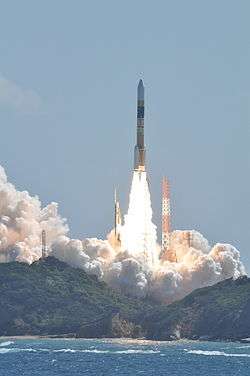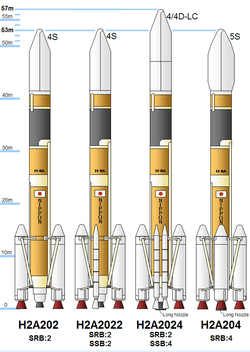H-IIA
H-IIA (H-2A) is an active expendable launch system operated by Mitsubishi Heavy Industries (MHI) for the Japan Aerospace Exploration Agency. The liquid-fueled H-IIA rockets have been used to launch satellites into geostationary orbit, to launch a lunar orbiting spacecraft, and to launch Akatsuki, which studied the planet Venus. Launches occur at the Tanegashima Space Center. The H-IIA first flew in 2001. As of February 2020, H-IIA rockets were launched 41 times, including 35 consecutive missions without a failure, dating back to 29 November 2003.
 The H-IIA No. F23 rolls out to the launch pad in February 2014. | |
| Function | Medium-lift launch vehicle |
|---|---|
| Manufacturer |
|
| Country of origin | Japan |
| Cost per launch | US$90 million |
| Size | |
| Height | 53 m (174 ft) |
| Diameter | 4 m (13 ft) |
| Mass | 285,000–445,000 kg (628,000–981,000 lb) |
| Stages | 2 |
| Capacity | |
| Payload to LEO | 10,000–15,000 kg (22,000–33,000 lb) |
| Payload to GTO | 4,100–6,000 kg (9,000–13,200 lb) |
| Associated rockets | |
| Family | H-II |
| Derivatives | H-IIB |
| Launch history | |
| Status | Active |
| Launch sites | Tanegashima, LA-Y |
| Total launches |
|
| Successes |
|
| Failures | 1 (2024) |
| First flight |
|
| Last flight |
|
| Notable payloads | |
| Boosters (All variants) – SRB-A | |
| No. boosters | 2–4 |
| Thrust | 2,260 kN (510,000 lbf) |
| Total thrust | 4,520–9,040 kN (1,020,000–2,030,000 lbf) |
| Specific impulse | 280 seconds (2.7 km/s) |
| Burn time | 120 seconds |
| Fuel | HTPB |
| Boosters (2022 / 2024) – Castor 4A-XL | |
| No. boosters | 2–4 |
| Thrust | 745 kN (167,000 lbf) |
| Total thrust | 1,490–2,980 kN (330,000–670,000 lbf) |
| Specific impulse | 280 seconds (2.7 km/s) |
| Burn time | 60 seconds |
| Fuel | Solid |
| First stage | |
| Engines | 1 LE-7A |
| Thrust | 1,098 kN (247,000 lbf) |
| Specific impulse | 440 seconds (4.3 km/s) |
| Burn time | 390 seconds |
| Fuel | LH2 / LOX |
| Second stage | |
| Engines | 1 LE-5B |
| Thrust | 137 kN (31,000 lbf) |
| Specific impulse | 447 seconds (4.38 km/s) |
| Burn time | 534 seconds |
| Fuel | LH2 / LOX |



Production and management of the H-IIA shifted from JAXA to MHI on 1 April 2007. Flight 13, which launched the lunar orbiter SELENE, was the first H-IIA launched after this privatization.[1]
The H-IIA is a derivative of the earlier H-II rocket, substantially redesigned to improve reliability and minimize costs. There are currently two (formerly four) different variants of the H-IIA in active service for various purposes. A derivative design, the H-IIB, was developed in the 2000s and made its maiden flight in 2009.
Vehicle description
The launch capability of an H-IIA launch vehicle can be enhanced by adding SRB-A (solid rocket booster or SRB) and Castor 4AXL (solid strap-on booster or SSB) to its basic configuration, creating a "family". The models are indicated by three or four numbers following the prefix "H2A". The first number in the sequence indicates the number of stages; the second number of liquid rocket boosters (LRBs); the third number of SRBs; and, if present, the fourth number shows the number of SSBs.[2] The first two figures are virtually fixed at "20", as H-IIA is always two-staged, and the plans for LRBs were cancelled and superseded by the H-IIB.
Variants
| Designation | Mass (tonnes) | Payload (tonnes to GTO) | Addon modules |
|---|---|---|---|
| H2A 202 | 285 | 4.1 | 2 SRB-A (SRB) |
| H2A 2022 (discontinued)[3] | 316 | 4.5 | 2 SRB-A (SRB) + 2 Castor 4AXL (SSB) |
| H2A 2024 (discontinued) | 347 | 5 | 2 SRB-A (SRB) + 4 Castor 4AXL (SSB) |
| H2A 204 | 445 | 6 | 4 SRB-A (SRB) |
| H2A 212 (cancelled) | 403 | 7.5 | 2 SRB-A (SRB) + 1 LRB [4][5] |
| H2A 222 (cancelled) | 520 | 9.5 | 2 SRB-A (SRB) + 2 LRBs [6] |
Launch history
The first H-IIA was successfully launched on 29 August 2001, followed by a string of successes.
The sixth launch on 29 November 2003, intended to launch two IGS reconnaissance satellites, failed. JAXA announced that launches would resume in 2005, and the first successful flight took place on 26 February 2005 with the launch of MTSAT-1R.
The first launch for a mission beyond Earth orbit was on 14 September 2007 for the SELENE moon mission. The first foreign payload on the H-IIA was the Australian FedSat-1 in 2002. As of March 2015, 27 out of 28 launches were successful.
A rocket with increased launch capabilities, H-IIB, is a derivative of the H-IIA family. H-IIB uses two LE-7A engines in its first stage, as opposed to one in H-IIA. The first H-IIB was successfully launched on 10 September 2009.
For the 29th flight on 24 November 2015, an H-IIA with an upgraded second stage[7] launched the Canadian Telstar 12V satellite, the first commercial primary payload for a Japanese launch vehicle.[8]
| Flight
No. |
Date (UTC) | Type | Payload(s) | Outcome |
|---|---|---|---|---|
| TF1 | 29 August 2001 07:00:00 | H2A 202 | Success | |
| TF2 | 4 February 2002 02:45:00 | H2A 2024 | Success | |
| F3 | 10 September 2002 08:20:00 | H2A 2024 | Success | |
| F4 | 14 December 2002 01:31:00 | H2A 202 | Success | |
| F5 | 28 March 2003 01:27:00 | H2A 2024 | Success | |
| F6 | November 29, 2003 04:33:00 | H2A 2024 | Failure | |
| A hot gas leak from SRB-A motor destroyed its separation system and the booster did not separate as planned. The weight of the spent motor prevented the vehicle from achieving its planned speed and height and it was destroyed via a ground command about 10 minutes into the flight.[9] | ||||
| F7 | 26 February 2005 09:25:00 | H2A 2022 | Success | |
| F8 | 24 January, 2006 01:33:00 | H2A 2022 | Success | |
| F9 | 18 February 2006 06:27:00 | H2A 2024 | Success | |
| F10 | 11 September 2006 04:35:00 | H2A 202 | Success | |
| F11 | 18 December 2006 06:32:00 | H2A 204 | Success | |
| F12 | 24 February 2007 04:41:00 | H2A 2024 | Success | |
| F13 | 14 September 2007 01:31:01 | H2A 2022 | Success | |
| F14 | 23 February 2008 08:55:00 | H2A 2024 | Success | |
| F15 | 23 January 2009 03:54:00 | H2A 202 | Success[10] | |
| F16 | 28 November 2009 01:21:00 [11] | H2A 202 | Success | |
| F17 | 20 May 2010 21:58:22[12][13][14] | H2A 202[15] | Success | |
| F18 | 11 September 2010 11:17:00[16] | H2A 202 | Success | |
| F19 | 23 September 2011 04:36:50[17] | H2A 202 | Success | |
| F20 | 12 December 2011 01:21:00[18] | H2A 202 | Success | |
| F21 | 17 May 2012 16:39:00 | H2A 202[19] | Success | |
| F22 | 27 January 2013 04:40:00 | H2A 202 | Success | |
| F23 | 27 February 2014 18:37:00 | H2A 202 | Success | |
| F24 | 24 May 2014 03:05:14 | H2A 202 | Success | |
| F25 | 7 October 2014 05:16:00 | H2A 202 | Success | |
| F26 | 3 December 2014 04:22:04 | H2A 202 | Success | |
| F27 | 1 February 2015 01:21:00 | H2A 202 | Success | |
| F28 | 26 March 2015 01:21:00 | H2A 202 | Success | |
| F29 | 24 November 2015 06:50:00 | H2A 204 | Success | |
| F30 | 17 February 2016 08:45:00 | H2A 202 | Success | |
| The Hitomi telescope broke apart 37 days after launch.[20] | ||||
| F31 | 2 November 2016 06:20:00 | H2A 202 | Success | |
| F32 | 24 January 2017 07:44:00 | H2A 204 | Success | |
| F33 | 17 March 2017 01:20:00 | H2A 202 | Success | |
| F34 | 1 June 2017 00:17:46 | H2A 202 | Success | |
| F35 | 19 August 2017 05:29:00 | H2A 204 | Success | |
| F36 | 9 October 2017 22:01:37 | H2A 202 | Success | |
| F37 | 23 December 2017 01:26:22 | H2A 202 | Success | |
| F38 | 27 February 2018 04:34:00 | H2A 202 | Success | |
| F39 | 12 June 2018 04:20:00 | H2A 202 | Success | |
| F40 | 29 October 2018 04:08:00 | H2A 202 | Success | |
| F41 | 9 February 2020 01:34:00 | H2A 202 | Success | |
See also
- Comparison of orbital launchers families
- Comparison of orbital launch systems
References
Notes
- "Mitsubishi and Arianespace Combine Commercial Satellite Launch Services". SatNews. Archived from the original on February 8, 2012.
- "H-IIA Launch Vehicle" (PDF). JAXA. p. 2. Archived from the original (PDF) on 2008-02-28. Retrieved 2007-09-15.
- 三菱重工、「H2A」2機種に半減・民営化でコスト減. NIKKEI NET
- https://www.spacedaily.com/reports/Japan_Reenters_Rocket_Race_With_New_Improved_H2A.html
- https://space.skyrocket.de/doc_lau/h-2a.htm
- https://www.spacedaily.com/reports/Japan_Reenters_Rocket_Race_With_New_Improved_H2A.html
- "Launch Result of Telstar 12 VANTAGE by H-IIA Launch Vehicle No. 29". JAXA. 24 Nov 2015. Retrieved 30 Nov 2015.
- William Graham (23 Nov 2015). "Japanese H-IIA successfully lofts Telstar 12V". NASASpaceflight.com. Retrieved 30 Nov 2015.
- "Launch Result of IGS #2/H-IIA F6". JAXA. November 29, 2003. Retrieved June 19, 2013.
- "Launch Result of the IBUKI (GOSAT) by H-IIA Launch Vehicle No. 15". MHI and JAXA. January 23, 2009.
- "H-IIA F16". Sorae. Archived from the original on 2012-02-18.
- "Launch Day of the H-IIA Launch Vehicle No. 17". JAXA. March 3, 2010.
- "Overview of Secondary Payloads". JAXA.
- Tariq Malik (18 May 2010). "New Venus Probe to Launch Thursday From Japan After". space.com. Retrieved 20 May 2010.
- Chris Bergin (17 May 2010). "JAXA launch H-IIA carrying AKATSUKI and IKAROS scrubbed". NASASpacflight.com. Retrieved 17 May 2010.
- "New Launch Day of the First Quasi-Zenith Satellite 'MICHIBIKI' by H-IIA Launch Vehicle No. 18". JAXA.
- Chris Bergin (23 September 2011). "Japanese H-2A launches with new IGS military satellite". NASASpaceflight.com.
- Chris Bergin (11 December 2011). "Japanese H-2A lofts IGS (Radar-3) satellite into orbit". NASASpaceflight.com.
- "Launch Overview – H-IIA Launch Services Flight No.21". Mitsubishi Heavy Industries. Retrieved April 15, 2012.
- Clark, Stephen (18 April 2016). "Attitude control failures led to break-up of Japanese astronomy satellite". Spaceflight Now. Retrieved 21 April 2016.
Sources
- "Japan Prepares for Crucial Rocket Launch". SPACE.com. Retrieved 16 February 2005.
- "H-IIA Expendable Launch Vehicle". SPACEandTECH. Archived from the original on February 4, 2012. Retrieved February 16, 2005.
External links
| Wikimedia Commons has media related to H-IIA. |